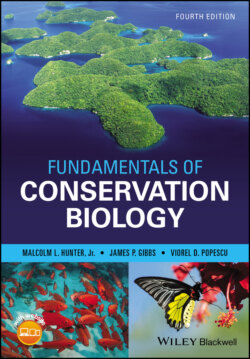Читать книгу Fundamentals of Conservation Biology - Malcolm L. Hunter Jr. - Страница 37
Summary
ОглавлениеBiodiversity is the variety of life in all its forms (plants, animals, fungi, bacteria, and other microorganisms) and at all levels of organization (genes, species, and ecosystems). Biodiversity includes these structural components, as well as functional components; that is, the ecological and evolutionary processes through which genes, species, and ecosystems interact with one another and with their environment. Conservation biologists often focus on maintaining structural biodiversity because if genetic, species, and ecosystem diversity are successfully maintained, then the diversity of ecological and evolutionary processes will probably be maintained as well.
Some elements of biodiversity can be measured with quantitative indices of diversity based on richness (the number of elements of biodiversity, usually the number of species) and evenness (their relative abundance). However, these indices can be misleading because a higher biodiversity index is not always desirable if the goal is maintaining biodiversity. It is more important to assess the risk of extinction of different species and emphasize those that are most endangered. The risk of extinction needs to be evaluated at different spatial scales (i.e. local, regional, and global), and emphasis needs to be placed on those species most at risk at the global scale because they are irreplaceable. The issue of biodiversity and spatial scale can also be addressed by thinking of diversity at three scales (alpha, within an ecosystem; beta, among ecosystems; and gamma, geographic scale) and by always assessing the large‐scale consequences whenever one manipulates biodiversity at a small scale. Thinking about biodiversity at large spatial scales will often reveal that it is inappropriate to advocate maximizing biodiversity. Instead, the goals should be to maintain natural levels of biodiversity or to restore biodiversity in ecosystems degraded by human activity. The goal of maintaining biodiversity is closely related to some other goals such as maintaining ecosystem or biotic integrity and ensuring sustainability of natural resource management, all of which are driven by human values that recognize the importance of the natural world.
